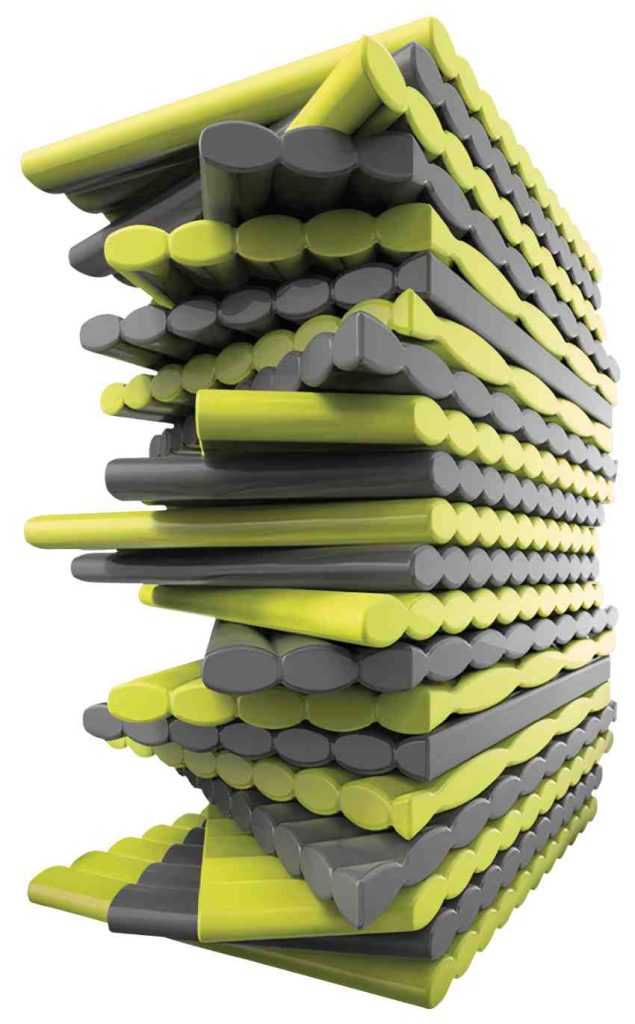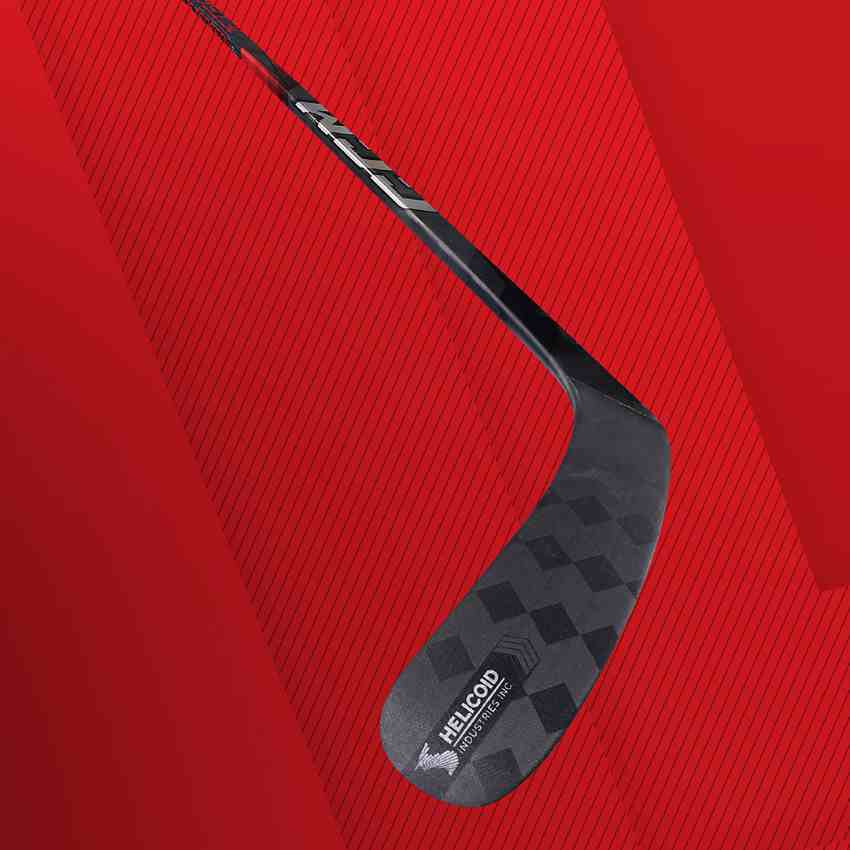Helicoid Industries is an innovative technology specializing in advanced composite architectures designed to improve impact resistance, reduce weight, and enhance structural integrity. The company’s proprietary helicoid architecture offers a revolutionary alternative to conventional composite laminates.
A brief description of the company and its activities
By mimicking natural helicoidal structures found in nature (e.g., the impact-resistant structure of mantis shrimp), Helicoid’s technology optimizes composite materials, typically carbon fiber or fiberglass, for a range of applications. Traditional composites are made with layers that often cross at 90 degrees which allows for very little energy transfer before fibers begin to break. Using helicoid’s patented layup of shallow angles of 10 – 15 degrees and then continuing to rotate the layup angles, create significantly more surface area to dissipate energy away from the point of impact. We tailor the helicoid rotation based on the materials being used and the performance required.
This can create improvements to protect against one large impact such as a bullet-proof vest, thousands of impacts like hockey pucks or golf balls, or millions of tiny impacts like rain droplets on a wind turbine blade. Helicoid’s technology significantly improves energy efficiency, enhances safety, all while reducing raw material use and overall production costs. With these enhancements, the company is well positioned to lead in various industries currently using, or considering the use of, composites.
What are the main areas of activity of the company?
Helicoid primarily targets industries that use composites materials in their products. This includes sectors like aerospace, automotive, sports equipment, and defense. Any sector that requires light, but durable materials to optimize performance, increase impact resistance, and reduce energy consumption can benefit from Helicoid’s technology. Helicoid’s architecture has shown significant benefits when replacing conventional composites in applications as varied as EV battery enclosures, aircraft components, sports gear, and even wind turbine blades. The technology is applicable to companies looking to create more sustainable, cost-efficient products without compromising strength or integrity.

What’s the news about new products/services?
Helicoid’s technology is gaining traction across various composite product markets by enhancing performance, decreasing weight, and lowering production costs. Recently, the company has expanded its footprint in the wind turbine industry, a significant move catalyzed by recent patent approvals. Following these approvals, Helicoid launched a targeted marketing campaign, which quickly captured the interest of three manufacturers who have now began the prototyping phase. This expansion marks a significant milestone for the company, as we now officially engaged in all major composite industries. By reducing the rate of erosion which improves the aerodynamics and overall power production of wind turbine blades, Helicoid’s architecture has the potential to significantly improve efficiency and operational lifespan in the renewable energy sector.
What are the ranges of products/services?
Helicoid’s technology can be applied to nearly any product currently using or considering the use of composite material. This includes a wide array of industries and product types. Helicoid supports manufacturers by providing an architecture that improves both structural and cost efficiency. The range is broad, covering products from sports equipment and automotive parts to wind turbine blades, defense equipment, and aerospace components. Essentially, Helicoid’s impact-focused and weight-reducing technology can be integrated into any composite material-based product to increase safety, performance, and sustainability.
What is the state of the market where you are currently active?
Helicoid’s active markets include sporting goods, automotive, defense, and aerospace, each with varying timelines and regulatory complexities. The sales cycle is shortest in the sporting goods sector, with products reaching consumers after approximately two years of development; Helicoid already has sporting goods products available and in customers’ hands. For automotive parts, the typical sales cycle spans three to five years, and we have over a dozen clients undergoing testing with several at the later stages.

Defense applications require a similar three- to five-year cycle, and Helicoid has made substantial progress with numerous projects in this sector. Aerospace represents the largest, but most demanding market, often requiring up to a decade for product adoption due to stringent regulatory hurdles. Helicoid is currently 20-30% through its aerospace cycle with promising results from over a dozen engaged customers. This diversified and tiered sales approach enables Helicoid to gradually enter each market segment, ensuring helicoid products meet thorough regulatory and performance validation.
What can you tell us about market trends?
The demand for composite materials is on a steady upward trajectory, largely driven by industries that prioritize weight reduction, enhanced performance, and energy efficiency—such as electric vehicles and aerospace. As the demand for lighter and more sustainable materials grows, so too does the interest in innovative solutions that can meet these criteria without the higher costs typically associated with composites. Helicoid addresses these issues directly, enhancing material performance, decreasing weight, and reducing production costs by more than 20% in many applications. This makes Helicoid’s architecture an appealing alternative as it not only improves product efficiency but also aligns with sustainability goals—a driving force in many of today’s markets. The rising emphasis on eco-friendly and cost-efficient solutions bodes well for Helicoid’s growth in the coming years.
What are the most innovative products/services marketed?
Helicoid’s unique approach allows clients to produce advanced, high-performing products across the composite spectrum. By incorporating helicoid technology, companies can create products that are not only stronger and more resilient but also more sustainable and cost-effective. With a customer base spanning over 50 diverse products and all major industries, Helicoid’s innovation potential is vast. Its customers include manufacturers of wind turbines, sports equipment, automotive parts, and defense equipment. Each product benefits from the unique properties of the helicoid architecture, enhancing impact resistance and lowering weight while also reducing costs. Helicoid’s innovation lies in its ability to support a wide variety of clients across these sectors, driving the composite market forward as a whole by increasing material efficiency and cost savings.

What estimations do you have for the rest of 2024?
As Helicoid continues to expand, 2024 marks a pivotal year for the company, as it recently launched a new financing round to support its rapid growth. With these funds, Helicoid plans to bring on additional team members to manage its expanding client base and further develop its sales channels. While the company’s technology has shown exceptional promise across multiple industries, the benefits of its ongoing efforts will take several years to materialize fully. In the meantime, Helicoid is focused on fostering its industry relationships and refining its marketing strategy to enhance its visibility in key sectors. Helicoid is highly optimistic about its trajectory for the coming years and anticipates that the company will see substantial financial growth as its market presence solidifies and client projects progress through their respective sales cycles. The firm is confident that all developments are heading in the right direction, setting a robust foundation for future success.


